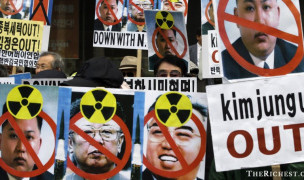 5 Terms
5 TermsHome > Terms > English (EN) > borderlands
borderlands
For nearly half its distance, the 1,947 kilometer US/Mexico border follows the Rio Grande river from Brownsville/Matamoros to El Paso/Ciudad Juárez, where it becomes a geometric line cutting across the Sonora and Mojave desert until it reaches San Diego/Tijuana. The region was sparsely populated until after the Second World War when development programs fostered the expansion of agriculture and agribusiness, trade, tourism and maquiladoras (assembly plants). Between 1930 and 1990, the population of El Paso increased from 102,421 residents to 515,342, while its “sister city” Ciudad Juárez grew from 19,669 to 789,522. During the same period San Diego went from 147,87 to 1,110,549 inhabitants, and Tijuana 8,384 to 698,752 inhabitants.
Because of this rapid growth, immigration, environmental and cultural issues have become a source of bi-national tension and concern. On a cultural level, the meaning of the border speaks directly to perceptions of US identity since many see it as a dividing line while others, including many Chicanos/as, emphasize the possibilities for cultural exchange and dialogue.
From 1521 to 1810, the settling of Northern Mexico—now the US Southwest—by Spanish soldiers, farmers and missionaries was sporadic because of violent confrontations with Native Americans and the region’s arid climate. Attempts to settle the region, which included devising policies aimed at attracting Anglo settlers, continued after Mexico gained independence from Spain in 1810. US expansion led to the US/ Mexico War and the signing of the Treaty of Guadalupe Hidalgo (1848), which ceded Northern Mexico to the US. As Anglo settlers moved into the region, they dispossessed—through force, legal maneuvers and purchase—Mexicans of their land. In the US, racial segregation was the rule as Mexican Americans were seen and treated as a cheap labor force.
The introduction of new irrigation techniques and railroad lines in the 1900s led to the expansion of agribusiness and the wider use of Mexicans as farm labor. The “bracero” program, which was started in 1942 to provide US agribusiness with temporary Mexican field-hands, brought thousands of Mexican workers to the Southwest. When the program was ended in 1964, many workers settled in the border region and continued migrating to the US.
By the 1960s the border region was the site of a number of industries, including agriculture, defense, technology, petroleum, real estate and tourism. The economies of border cities have become tightly linked as goods, labor (both legal and illegal), tourists, shoppers and plant managers cross the border on a daily basis. On the Mexican side, the government promoted maquila (assemblyplant) manufacturing in cities such Tijuana, Piedras Negras, Ciudad Juárez and Nuevo Laredo. The Mexican Border Industrialization Program, which was started in 1965, sought to take advantage of the low-wages paid to and the high productivity of the Mexican workforce. The program allowed for the dutyfree importation of machinery equipment and materials under the condition that everything produced was exported. By 1975, 67,214 were employed in maquilas, by 1990, 460,293. The majority of these plants engaged in electronic and furniture assembly and textile production. Maquilas have generated controversy because of their low-wages, reliance on young women as employees, ecological impact and inability to provide jobs for the large number of migrants to the border region.
In order to control the entry of illegal immigrants the US has begun to militarize the border, including deploying marines for patrol duty. Militarization and violence on the border have led to concerns over the protection of human rights. Groups such as America’s Watch have written reports critical of the Immigration and Naturalization Service’s ability to guarantee the rights of legal and illegal immigrants. Attempts to limit illegal immigration—such as the 1986 Immigration Reform and Control Act which included employer sanctions for hiring undocumented workers—have had little impact on the migrant flow. Many of these issues of crossing and employment are depicted in the movie El Norte (1989). Most analysts agree that as long as there exists such a large disparity in Mexican and US wage rates—and a demand in the US for Mexican labor— illegal immigration will continue.
As a result of border industrialization, environmental problems have generated new legal issues and highlighted the need for greater bi-national cooperation. Problems such as cross-border flooding, sewage spills, the disposal of hazardous waste and air pollution have drawn the attention of environmental groups and policy-makers. Untreated waste from Tijuana has polluted beaches near San Diego and over half of the maquilas, most of which are owned by US and Japanese companies, have toxic-discharge problems. After 1990, with the signing of the North American Free Trade Agreement, both the US and Mexican governments began to voice concern over borderland environmental conditions.
In 1992 US and Mexican environmental agencies devised the Integrated Border Environmental Plan, which focused mainly on educational programs and information sharing while paying little attention to enforcement. A number of US and Mexican nongovernmental organizations have formed to pressure for improving environmental conditions.
For many who view US culture as being homogenous and bounded, the complexities and permeability of the border represent a diluting of US culture and ideals. Many Chicanos/as have challenged this view by emphasizing the porous and creative nature of identity and culture; cultural borderlands are not threatening exceptions, but rather regions of cultural exchange and dialogue. Indeed, this rethinking of US identity is needed for transforming perceptions of the US/Mexico border from a closed dividing line to a region where new forms of bi-national cooperation and cultural expression should be fostered and encouraged.
- Part of Speech: noun
- Synonym(s):
- Blossary:
- Industry/Domain: Culture
- Category: American culture
- Company: Routledge
- Product:
- Acronym-Abbreviation:
Other Languages:
Member comments
Terms in the News
Billy Morgan
Sports; Snowboarding
The British snowboarder Billy Morgan has landed the sport’s first ever 1800 quadruple cork. The rider, who represented Great Britain in the 2014 Winter Olympics in Sochi, was in Livigno, Italy, when he achieved the man-oeuvre. It involves flipping four times, while body also spins with five complete rotations on a sideways or downward-facing axis. The trick ...
Marzieh Afkham
Broadcasting & receiving; News
Marzieh Afkham, who is the country’s first foreign ministry spokeswoman, will head a mission in east Asia, the state news agency reported. It is not clear to which country she will be posted as her appointment has yet to be announced officially. Afkham will only be the second female ambassador Iran has had. Under the last shah’s rule, Mehrangiz Dolatshahi, a ...
Weekly Packet
Language; Online services; Slang; Internet
Weekly Packet or "Paquete Semanal" as it is known in Cuba is a term used by Cubans to describe the information that is gathered from the internet outside of Cuba and saved onto hard drives to be transported into Cuba itself. Weekly Packets are then sold to Cuban's without internet access, allowing them to obtain information just days - and sometimes hours - after it ...
Asian Infrastructure Investment Bank (AIIB)
Banking; Investment banking
The Asian Infrastructure Investment Bank (AIIB) is an international financial institution established to address the need in Asia for infrastructure development. According to the Asian Development Bank, Asia needs $800 billion each year for roads, ports, power plants or other infrastructure projects before 2020. Originally proposed by China in 2013, a signing ...
Spartan
Online services; Internet
Spartan is the codename given to the new Microsoft Windows 10 browser that will replace Microsoft Windows Internet Explorer. The new browser will be built from the ground up and disregard any code from the IE platform. It has a new rendering engine that is built to be compatible with how the web is written today. The name Spartan is named after the ...
Featured Terms
Snow
Since its launch in 2004 Snow has built a solid reputation as the world’s largest beer brand, taking the title of best-selling beer in the world for a ...
Contributor
Featured blossaries
Marouane937
0
Terms
58
Blossaries
3
Followers
5 of the World’s Most Corrupt Politicians
 5 Terms
5 Terms
dnatalia
0
Terms
60
Blossaries
2
Followers
Herbs and Spices in Indonesian Cuisine
 10 Terms
10 Terms
Browers Terms By Category
- Hats & caps(21)
- Scarves(8)
- Gloves & mittens(8)
- Hair accessories(6)
Fashion accessories(43) Terms
- Alcohol & Hydroxybenzene & Ether(29)
- Pigments(13)
- Organic acids(4)
- Intermediates(1)
Organic chemicals(47) Terms
- Action toys(4)
- Skill toys(3)
- Animals & stuffed toys(2)
- Educational toys(1)
- Baby toys(1)
Toys and games(11) Terms
- Social media(480)
- Internet(195)
- Search engines(29)
- Online games(22)
- Ecommerce(21)
- SEO(8)


